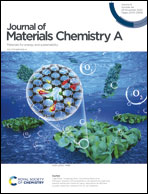Incorporation of alkylthio side chains on benzothiadiazole-based non-fullerene acceptors enables high-performance organic solar cells with over 16% efficiency†
Abstract
Y6-type non-fullerene acceptors (NFAs) with an acceptor–donor–acceptor′–donor–acceptor (A–D–A′–D–A) structure have been very popular in the field of organic solar cells (OSCs) due to their excellent performances. In this study, two novel NFAs, BTPS-4F and BTPS-4Cl were designed by incorporating undecylthio side chains into a thienothiophene moiety and connecting it to two different halogenated 2-(3-oxo-2,3-dihydroinden-1-ylidene)malononitrile end groups (2F-IC and 2Cl-IC) respectively. When blended with a donor polymer, PM6, BTPS-4F-based devices achieved a high power conversion efficiency (PCE) of up to 16.2% with an open-circuit voltage (VOC) of 0.82 V, a short-circuit current density (JSC) of 25.2 mA cm−2 and a fill factor (FF) of 0.78, while BTPS-4Cl-based devices achieved an inferior PCE of 13.5%. This is the first time alkylthio chains are employed on Y6-like NFAs to achieve high-performance OSCs. Subsequent characterization showed that the upshifted energy level of BTPS-4F and the better intermolecular packing in PM6:BTPS-4F blends are the major reasons for the enhanced performance of BTPS-4F-based devices over BTPS-4Cl-based ones. This work provides high-performance non-fullerene acceptors for OSCs and demonstrates a promising molecular design strategy that can effectively regulate their energy levels and morphology.



 Please wait while we load your content...
Please wait while we load your content...
